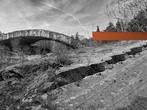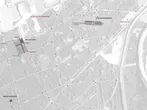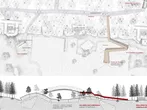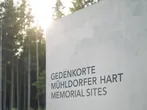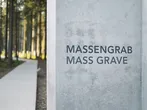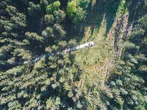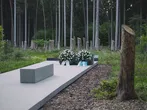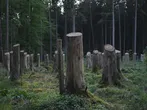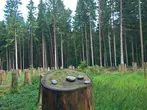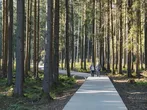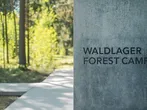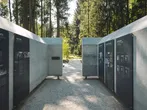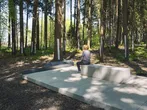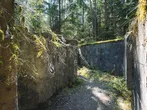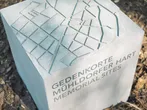MÜHA
Memorial Place Mühldorfer Hart, DE
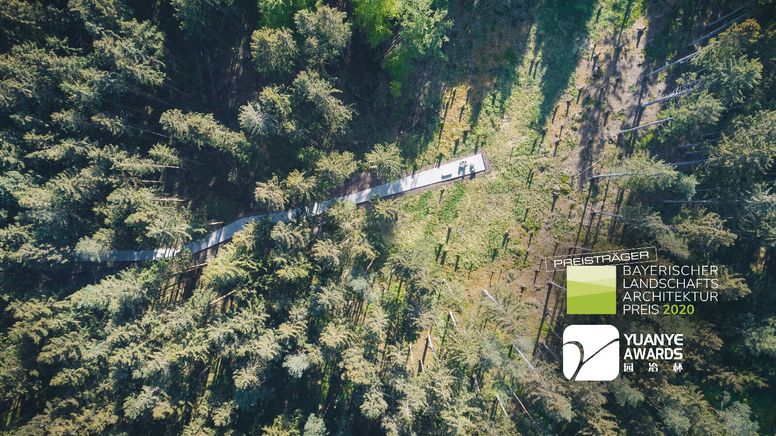
Understanding links - against oblivion
The bunker construction site in a forest near the small Upper Bavarian town of Mühldorf was the second largest satellite camp of the Dachau concentration camp and it claimed more than 5000 lives towards the end of World War II. The three memorial sites, Forest Camp, Mass Grave and Armament Bunker, represent a complex system of air and rail traffic, production and storage areas, construction site huts, prisoners’ camps and graves, which commemorate forced labour, survival and the death of prisoners.
The site was blown up by the Allies and gradually reclaimed by the forest, making its remains incomprehensible without the help of additional information for interpretation. By superimposing a new abstract layer over the existing landscape, the past is remembered and the inexplicable becomes comprehensible. The actual process of understanding is triggered by the conscious perception of what is seen, simple spatial interventions and only a minimum of essential factual information. The repetition of elements and information highlights the interchangeability of places in relation to their historical context.
Consequently, the new elements are not reconstructions. They are media with the highest demands on form and material. They deliberately use the characteristic materials of the bunker construction site: concrete and some steel in a few places for information signs.
All three memorial sites tell the same story in different ways and are part of an overall network.
Memorial stones, as symbolic representations of the Mühldorfer Hart network, are placed at historically and spatially relevant points. To come across them seems to be coincidental and yet raises awareness of the place and its context.
Spatial interventions such as paths and junctions, clearings and swathes help to fathom the former structure and dimensions. Each of the three memorial sites is preceded by the same introverted information space, which uses images and texts to inform about the entire Mühldorfer Hart site and that particular spot. Thus prepared, visitors pass a “turnstile”, consisting of two U-shaped concrete units, and are discharged to a new level, the actual memorial site.
The constructed paths are part of the process of understanding. They respond to existing site elements, vary in width, adapt and lead to scattered relics in order to facilitate remembrance. Their surface is soft at the start near the forest road, while beyond the turnstile they turn into narrative paths that lead to the memorial site and are made of bespoke concrete units that are slightly raised above the forest floor. Laterally mounted steel bands carry commemorative quotations from contemporary witnesses that remember historically important places and events.
The “Forest Camp VI Memorial Site” serves as an example of several camps where prisoners lived under the most inhumane conditions. By removing vegetation, the main axes and boundaries as well as the earth huts at the winter camp are revealed and give an idea of the camp’s extent. Memorial stones mark the spots of former watchtowers and gates. The path starts at the information room near the old camp gate, runs first along the former main axis, then veers off to the south towards the earth huts and latrines, and turns north to the former roll call ground. White markings on the tree trunks demarcate the extent of the now overgrown roll call ground.
The “Mass Grave Memorial Site” comprises two of a few still discernible mass graves. It now lies peacefully within a forest and yet stands for countless bodies that were buried indiscriminately – a dimension that is difficult to convey. A clearing with lopped off tree trunks demystifies the place, confronting visitors with an unexpected, shocking picture: the 1.7-metre-high tree stumps represent the victims and the madness of a criminal system.
The “Armament Bunker Memorial Site” has not yet been completed. The seventh bunker arch, which is still standing after it was blasted, is the most striking relic at Mühldorfer Hart. A steel walkway will be constructed on the remains of the fifth arch to provide an overview of the extent of the scene of devastation: the former centre of a planned arms factory – and the reason for forced labour and mass death.
Awards:
- YUANYEAWARD for Professionals 2020 in der Kategorie Besondere Landschaft und Park und für den Gold Award
1st prize in the invited competition 2012
Design and implementation of the Forest Camp and Mass Graves phases: 2013 – 2018
Tender specification and site management in cooperation with Zankl&Francke, a subcontractor to Latz+Partner
Client: Stiftung Bayerische Gedenkstätten
Total site area: 100 hectares
Award:
Nominated for the Bavarian Landscape Architecture Award 2020 (main prize) and in the category Building in Existing Contexts / Monuments
